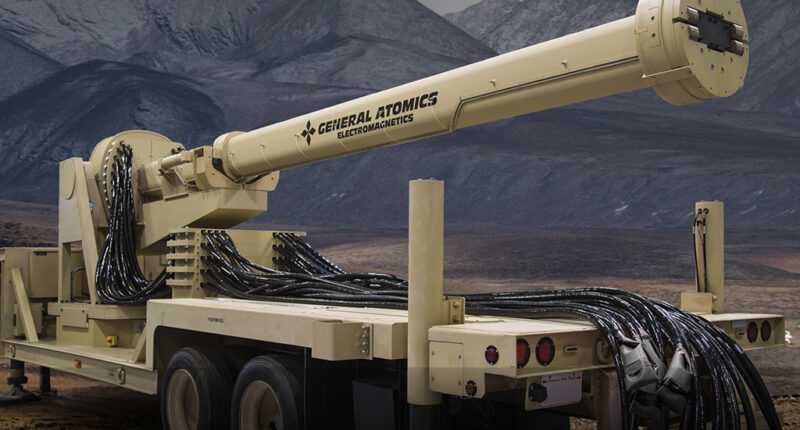
General Atomics is reviving the railgun program with a new generation of electromagnetic weapons capable of firing hypersonic tungsten-pellet payloads.
General Atomics Electromagnetic Systems (GA-EMS) is pushing its railgun program forward, positioning it as a potential modern air defense solution for saturation attacks and high-speed threats.
The effort centers on an electromagnetic weapon designed to fire projectiles at hypersonic speeds, giving them the velocity and kinetic energy needed to engage ballistic and cruise missiles.
Mike Rucker, head of GA-EMS Weapons Programs, told Naval News that the platform’s extreme muzzle velocity will serve as the key in providing the speed needed to intercept very fast targets.
He also noted that the weapon uses tungsten-pellet payloads, conceptually similar to airburst rounds used by some anti-aircraft guns, which could offer a lower-cost effect per engagement than conventional interceptor missiles.
Rucker said the company has already pitched its railgun for the Pentagon’s Golden Dome initiative, aiming to secure a role in America’s next-gen air defense.
Railgun Lineup
General Atomics said it has three scalable railgun designs.
The smallest, a 3-megajoule demonstrator dubbed “Blitzer,” is roughly the size of a 35mm gun.
A 10-megajoule medium-caliber model is comparable to the size of a howitzer, while the more powerful 32-megajoule variant is larger than a 155mm artillery system.
Open-source defense observers noted that if the US military explores railgun deployment again, it may start with smaller, lower-power models like the Blitzer to validate the concept for airburst interception roles.
Technical Progress — and the Old Roadblocks
General Atomics will continue to tackle challenges that sidelined earlier railgun programs in the US, including rapid barrel wear, heat buildup from repeated firings, and the massive power requirement for sustained rates of fire.
But the company’s experience in electromagnetic aircraft launch systems for US Navy carriers is expected to provide a technical foundation for the railgun, helping maintain progress on the current initiative.
Its latest railgun prototypes have reportedly pushed projectile speeds to at least Mach 6 (7,409 kilometers/4,604 miles per hour), about twice the velocity of many conventional naval and anti-aircraft guns.
Global Context
Research into railgun-style electromagnetic launchers is not unique to the US.
Japan and China remain active in naval railgun development, and Turkey has pursued related efforts with the ŞAHİ 209 and ASELSAN TUFAN, though little public information has emerged in recent years.
The US Navy halted all efforts related to its electromagnetic railgun in 2021 after spending approximately half a billion dollars over 15 years.